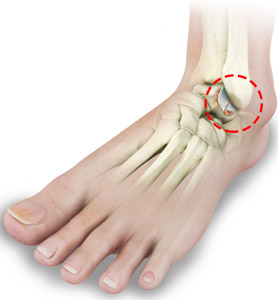Ankle Arthritis

What is Ankle Arthritis?
Arthritis is inflammation resulting from the degeneration of cartilage in the joint causing joint pain, swelling, and stiffness resulting in restricted movements. Arthritis of the ankle joint can occur due to fractures, dislocation, inflammatory disease, or congenital deformity. The foot joints most commonly affected by arthritis are:
- The joint between the shinbone (tibia) and ankle bone (talus)
- The three joints of the foot that include the heel bone, the inner mid-foot bone, and the outer mid-foot bone
- The joint of the great toe and foot bone
What are the Types of Ankle Arthritis?
There are three types of arthritis affecting the ankle and may include:
Osteoarthritis : Also, called degenerative joint disease, this is the most common type of arthritis and occurs most often in older people. This disease affects cartilage, the tissue that cushions and protects the ends of bones in a joint. With osteoarthritis, the cartilage starts to wear away over time. In extreme cases, the cartilage can completely wear away, leaving nothing to protect the bones in a joint, causing bone-on-bone contact. Bones may also bulge, or stick out at the end of a joint, called bone spurs.
Rheumatoid Arthritis: This is an auto-immune disease in which the body’s immune system (the body’s way of fighting infection) attacks healthy joints, tissues and organs. It can cause pain, stiffness, swelling, and loss of function in joints. Rheumatoid arthritis affects mostly joints of the hands and feet and tends to be symmetrical. This means the disease affects the same joints on both sides of the body (both feet) at the same time and with the same symptoms.
Post-traumatic Arthritis: Arthritis that develops following an ankle or foot injury is called post-traumatic arthritis. The condition may develop years after the trauma such as a fracture, severe sprain or ligament tears.
What are the Symptoms of Ankle Arthritis?
Symptoms of ankle arthritis include pain or tenderness, swelling, stiffness in the joint and limited range of motion.
How is Ankle Arthritis Diagnosed?
The diagnosis of ankle arthritis is made with a medical history, physical examination and X-rays of the affected joint. A bone scan, computed tomography (CT) scans and magnetic resonance imaging (MRI) scans are also performed to diagnose arthritis.
What are the Treatment Options for Ankle Arthritis?
Non-surgical treatment options for ankle arthritis include medications (anti-inflammatories), injections (steroids), physical therapy, ankle-foot orthosis (AFO), weight loss, orthotics such as pads or arch supports, and canes or braces to support the joints. Surgery may be required to treat ankle arthritis if your symptoms do not improve with conservative treatments. Surgery performed for arthritis of the ankle includes:
Arthroscopic Surgery : Arthroscopy is a surgical procedure during which the internal structure of a joint is examined for diagnosis and treatment of problems inside the joint. In arthroscopic examination, a small incision is made on the patient’s skin through which pencil-sized instruments with a small lens and lighting system (arthroscope) are passed. Arthroscopes magnify and illuminate the structures of the joint with the light that is transmitted through fibre optics. The scope is attached to a television camera and the interior of the joint is seen on a television monitor. Your surgeon can then use probes, forceps, knives and shavers to clean the joint area of foreign tissue, inflamed tissue or bony outgrowths (spurs).
Arthroplasty or Joint Replacement : In this procedure, your surgeon removes the damaged ankle joint and replaces it with an artificial implant. It is usually performed when the joint is severely damaged by osteoarthritis, rheumatoid arthritis or post-traumatic arthritis. The goal of ankle replacement is to relieve pain and restore the normal function of the ankle joint.
Ankle arthrodesis: The ankle joint is formed by the tibia, talus, and fibula bones. Ankle arthrodesis involves the surgical fusion of the bones that form the ankle joint. It is usually recommended for the treatment of severe end-stage arthritis not responding to conservative treatment measures. The goal of ankle arthrodesis is to relieve pain in the affected joint. This is achieved by surgically eliminating the joint.
Related Topics
- Sprained Ankle
- Achilles Tendinitis
- Ankle Arthritis
- Ankle Instability
- Ankle Fractures
- Arthritis of the Ankle
- Achilles Tendon Problems
- Heel Pain
- Ankle Stress Fractures
- Corns
- Posterior Tibial Tendon Dysfunction
- Ankle Rheumatoid Arthritis
- Talus Fractures
- Vertical Talus
- Heel Spur
- Medial Gastrocnemius Strain




